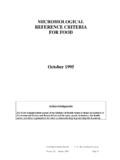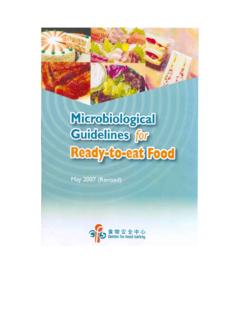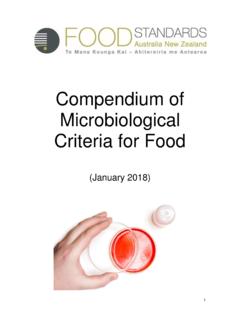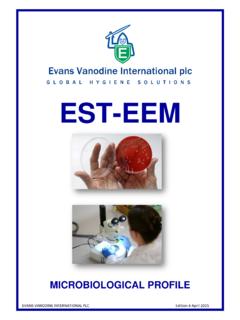Transcription of Industry Guide to Good Hygiene - Dairy Transport
1 Industry Guide to good Hygiene Practice Milk and Dairy Products Regulation (EC) 852/2004 The Hygiene of foodstuffs Regulation (EC) 853/2004 Hygiene rules for food of animal origin Regulation (EC) 2073/2005 Microbiological criteria for foodstuffs (as amended by EC Regulation No. 1441/2007. and Regulation No. 365/2010). August 2010. CONTENTS. Page Industry Guide to good Hygiene Practice Number Preface 5. Acknowledgement 6. Introduction 7. Scope 8. Structure of the Guide 9. Legal background 10 11. HACCP 12 - 14. Regulation 852/2004 The Hygiene of foodstuffs 15 53. HACCP 15 - 16. General requirements for food premises 17 22. Specific requirements in rooms where foodstuffs are prepared, 23 27. treated or processed Requirements for movable and temporary premises 28 30. Transport 31 34. Equipment requirements 35 37. food Waste 38 39.
2 Water Supply 40 41. Personal Hygiene 42 44. Provisions applicable to foodstuffs 45 48. Wrapping and Packing 49 50. Heat Treatment 51. Training 52 53. Regulation 853/2004 Hygiene rules for food of animal origin 54 79. Primary Production 55 60. Milk Production Holdings 61 - 63. Milking, Collection and Transport 64 65. Staff Hygiene 66. Criteria for Raw Milk 67 69. Dairy Products - Temperature 70 - 71. Heat Treatment 72 75. Criteria for Raw Cows' Milk 76. Wrapping and Packing 77. Industry Guide to good Hygiene Practice: Milk and Dairy Products 3. Labelling 78. Identification Marking 79. Regulation 2073/2005 Microbiological criteria for foodstuffs 80 90. Microbiological Criteria for Milk and Dairy Products 80 82. food Safety Criteria 83 87. Process Hygiene Criteria 88 90. References 91. Glossary 92 - 95. Annex 96 - 97. Industry Guide to good Hygiene Practice: Milk and Dairy Products 4.
3 Preface This Industry Guide to good Hygiene Practice gives advice to the Dairy Industry on how to comply with the EU legislation. This is an official Guide to the Regulations which has been developed in accordance with Articles 7-8 of the EC Regulation on the Hygiene of foodstuffs (Regulation No 852/2004). The guidance also includes an annex on non-exhaustive list of establishments subject to approval under Regulation (EC) 853/2004. Whilst the guidance given in this Guide is not legally binding, food Authorities must give its content due consideration when enforcing the Regulations. Therefore food Business Operators whilst not legally bound to follow the guidance, must be prepared to justify if they do not do so. Industry Guide to good Hygiene Practice: Milk and Dairy Products 5. Acknowledgements The Members of the good Hygiene Practice Working Party for the Dairy Sector who prepared the Guide were: Chairman Mr Tim Hampton, Milk Link Other Members Ms Joyce Stangoe Ms Adenike Olatunji Dairy Farmers of Britain Dairy UK.
4 Mr Calum MacGregor Ms Karen Pratt Robert Wiseman Dairies food Standards Agency Ms Diana Brydson Ms Clare Cheney First Milk Specialist Cheesemakers Ms Suzanne Christie Association EHO, Huntingdonshire District Ms Angela Jones Council Dairy Crest Dr Ed Komorowski Ms Rowena Marshall Dairy UK Arla Foods UK. Mr Mike Overfield-Collins Mr David Lock Milk Link Local Government Regulation Ms Geraldine Hoad food Standards Agency Industry Guide to good Hygiene Practice: Milk and Dairy Products 6. Introduction This Guide has been produced by Dairy UK on behalf of the Dairy Sector and is intended to assist, milk producers, processors and all other Dairy manufacturing establishments to meet the legal requirements of Regulation (EC) 852/2004 on the Hygiene of foodstuffs and Regulation (EC) 853/2004 laying down specific Hygiene rules for food of animal origin.
5 The latter regulation has been amended by Regulations (EC) 1662/2006, (EC) 1664/2006, (EC) 2074/2005, (EC). 2076/2005 and (EC) 1020/2008 and these modifications have been taken into account in this Guide . In order to make this Guide self contained it contains relevant extracts from Regulation (EC) 2073/2005 and from the food Standards Agency general guidance on it. Industry Guide to good Hygiene Practice: Milk and Dairy Products 7. Scope This Guide is intended to apply to Milk and Dairy Products. Industry Guide to good Hygiene Practice: Milk and Dairy Products 8. Structure of the Guide This Guide has been structured into four different major parts Hazard Analysis and Critical Control Point (HACCP). Regulation (EC) 852/2004 on the Hygiene of foodstuffs Regulation (EC) 853/2004 laying down specific Hygiene rules for food of animal origin Regulation (EC) 2073/2005 Microbiological Criteria for foodstuffs This Guide has been arranged in the order of each of the regulations themselves.
6 Each section includes reference to the regulation which is the legal requirement, followed by guidance to compliance, which is advice on how to comply, and advice on good practice which goes further than the law requires which you can follow if you wish. Some sections applying to Regulation (EC) 853/2004 include a short introduction which may help to explain the relevance of the legal requirement. This guidance contains a glossary giving the meaning of some of the terms used. Industry Guide to good Hygiene Practice: Milk and Dairy Products 9. LEGAL BACKGROUND. From 1 January 2006, new EU food Hygiene legislation has applied throughout the UK. The package of legislation: Modernises, consolidates and simplifies the previous EU food Hygiene legislation Applies effective and proportionate controls throughout the food chain, from primary production to sale or supply to the final consumer Focuses controls on what is necessary for public health protection Clarifies that it is the primary responsibility of food business operators to produce food safely As EU regulations, the legislation is directly applicable law.
7 The regulations are: Regulation (EC) 852/2004 (as amended) on the Hygiene of foodstuffs Regulation (EC) 853/2004 (as amended) laying down specific Hygiene rules for food of animal origin Regulation (EC) 854/2004 laying down specific rules for the organisation of official controls on products of animal origin intended for human consumption The general Hygiene requirements for all food business operators are laid down in Regulation 852/2004. Regulation 853/2004 supplements Regulation 852/2004. in that it lays down specific requirements for food businesses dealing with foods of animal origin. Regulation 854/2004 relates to the organisation of official controls on products of animal origin intended for human consumption. The legislation introduces a 'farm to fork' approach to food safety, by including primary production (that is, farmers and growers) in food Hygiene legislation, for the first time in the majority of cases.
8 All food businesses should be registered with or approved by the relevant competent authority, normally the local authority environmental health department. The new legislation also requires food business operators (except farmers and growers) to put in place, implement and maintain a permanent procedure, or procedures, based on HACCP principles although the legislation is structured so that it can be applied flexibly and proportionately according to the size and nature of the food business. Industry Guide to good Hygiene Practice: Milk and Dairy Products 10. The food Hygiene (England) Regulations 2006 provide for the execution and enforcement of the above European Regulations in England. Similar Regulations apply in Wales, Scotland and Northern Ireland. Industry Guide to good Hygiene Practice: Milk and Dairy Products 11.
9 Hazard Analysis and Critical Control Points (HACCP). HACCP is science based and systematic; it identifies specific hazards and measures for their control to ensure the safety of a process. HACCP is a tool to identify and assess hazards and establish control systems that focus on prevention rather than relying mainly on end-product testing. Any HACCP system should be capable of accommodating change, such as advances in equipment design, processing procedures or technological developments. HACCP can be applied throughout the food chain from primary production to final consumption and its implementation should be guided by scientific evidence of risks to human health. As well as enhancing food safety, implementation of HACCP can provide other significant benefits, for example the application of HACCP can aid inspection by regulatory authorities and promote international trade by increasing confidence in food safety.
10 The successful application of HACCP requires the full commitment and involvement of management and the work force. It also requires a multidisciplinary approach; this multidisciplinary approach should include, where appropriate, expertise in agronomy, veterinary Hygiene , production, microbiology, medicine, public health, food technology, environmental health, chemistry and engineering. Prior to application of HACCP to any business the food business operator should have implemented the prerequisite food Hygiene requirements. Prerequisite is also referred to as basic good Hygiene conditions and practices. This will include procedures for cleaning and sanitation, maintenance, personal Hygiene and training, pest control, plant and equipment, premises and structure, storage, distribution and Transport , waste management etc.







